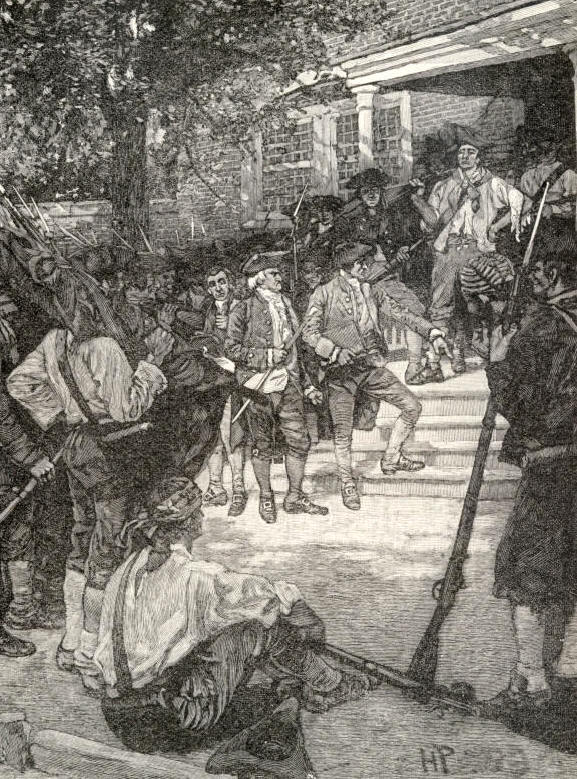Shays' Rebellion
|
|
This Site:
|
Shays, DANIEL, insurgent; born in Hopkinton, Massachusetts, in 1747; was an ensign in Woodbridge's regiment at the battle of Bunker Hill, and became a captain in the Continental army. His place in history was obtained by his leadership of an insurrection in Massachusetts in 1786-87. In other portions of the Union, discontents like those which produced the State of FRANKLAND caused revolutionary movements. A convention of the people of Maine, sitting in Portland (September, 1786), considered the expediency of erecting themselves into an independent State, but nothing came of it. In Massachusetts a more formidable movement took place. The General Court had voted customs and excise duties to produce a revenue sufficient to meet the interest on the State debt. Besides this burden laid upon them, the people were suffering from private indebtedness. There were taxes to meet the installments to be paid on the principal of the State debt, and, also, responses had to be made to requisitions of Congress for the proportion of money required from Massachusetts for carrying on the general government. The taxes of the State amounted annually to $1,000,000. Many of the farmers had fallen behind in their payments. A multitude of lawsuits were pending in the courts. Conventions were called, especially in the southern and western counties, to consider their grievances, and these were sometimes followed by argued mobs which prevented the courts from sitting.
Mob in Shays's RebellionThe poverty and exhaustion of the country in consequence of the war was complete. Artful demagogues stirred up the people of one class against those of another. The working-men were arrayed against the capitalists. The government of Massachusetts was held responsible for every evil; and these demagogues, seeking notoriety, so inflamed the people that large masses were ready to take up arms for the overthrow of the commonwealth. In this disturbed state of the public mind, the governor of Massachusetts (Bowdoin) called (September, 1786) a special session of the legislature. Unsuccessful attempts were made to pacify the malcontents, when the governor called out the militia to protect the courts in the south-western counties. The Congress, fearing the dissatisfied people might seize the government armory at Springfield, voted to enlist 1,300 men (October, 1786) under pretext of acting against Indians in the Northwest; but before these troops could be raised, an insurrection had already broken out. Shays, at the head of 1,000 men or more, took possession of Worcester (December 5) and prevented a session of the Supreme Court in that town. He repeated this act at Springfield (December 25). The insurrection soon became so formidable that Governor Bowdoin was compelled to call out several thousand militia, under General Lincoln, to suppress it. They assembled at Boston (January 17, 1787) in the depth of winter, and marched for Worcester and Springfield. Two other bodies of insurgents were then in the field under the respective commands of Luke Day and Eli Parsons. United, they numbered about 2,000. Shays demanded the surrender (January 25) of the arsenal at Springfield, and approached to take it. Colonel Shepherd, in command there, first fired cannon over their heads. When the pieces were pointed at the insurgents, they cried "Murder!" and fled in confusion. Upon Lincoln's approach (January 27) the insurgents retreated. Finally, he captured 150 of them at Petersham; the rest were dispersed and fled into New Hampshire. Lincoln then marched into the districts west of the Connecticut River, where the insurgents were numerous. Their power was speedily broken. A free pardon was finally offered to all persons who had engaged in the insurrection. Several of the leaders were tried and sentenced to death, but none were executed; for it was perceived that the great mass of the people sympathized with them. So ended what is known in history as Shays's Rebellion. Shays died in Sparta, New York, Sept. 29, 1825. |
|
|
||
|
|
Site Copyright 2003-2018 Son of the South. For Questions or comments about this collection, contact: paul@sonofthesouth.net |
|
|
Are you Scared and Confused? Read My Snake Story, a story of hope and encouragement, to help you face your fears. |
||
